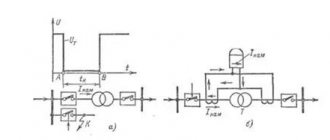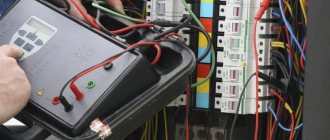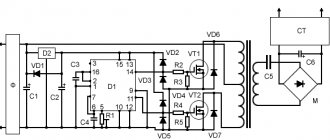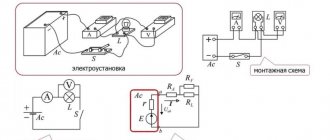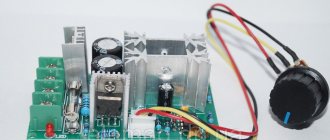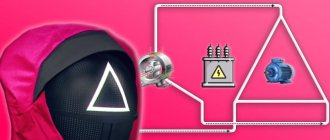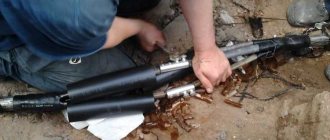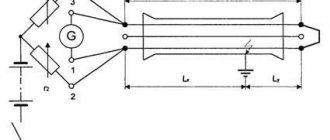Checking electronic equipment and all types of tires can be done in different ways. For example, to determine the degree of electrodynamic stability, a short-circuit shock current (isp) is used, the value of which is determined by calculations. At its core, this value is the maximum instantaneous value of the total short-circuit current. This characteristic can be calculated at the stage between the absence of current in the previous mode and the maximum indicator of the aperiodic component.
Short circuit components
Before discussing the shock current, it is necessary to consider what parts the total short circuit current consists of. It is known that its main components are the free aperiodic part and the forced periodic component. The short-circuit current reaches its maximum level at the highest values of both components.
The aperiodic current at the very beginning of its appearance becomes maximum at the moment of zero current value in the previous mode, which is idle. Immediately upon the occurrence of a short circuit, the forced current with a periodic component passes its maximum level. This condition becomes an indicator used in calculations. The total short-circuit current with the maximum instantaneous value is the short-circuit shock current.
In practice, this indicator is calculated at the maximum value of the aperiodic part. For this purpose, the mode preceding the accident, called idle, is selected. This network condition is considered one of the most complex compared to inductive or active-inductive pre-emergency current, in which the aperiodic part will be lower.
The conditions under which the aperiodic component is formed are shown in the figure. They are completely dependent on the previous state of the current before the emergency mode. The red vector corresponds to the pre-emergency current, the blue vector to the periodic short-circuit current. The green vector shows the difference between them, indicating the magnitude of the aperiodic current in the initial stage.
What happens in a circuit during a short circuit
So, the reader can consider that he has mastered all the main physical laws in order to understand what the magnitude (okay, let there be strength) of the short circuit current can be. But first you need to decide on the question of what, exactly, it is. A short circuit (short circuit) is a situation in which the load resistance is close to zero. Let's look at the formula of Ohm's law. If we consider its version for a section of the circuit, it is easy to understand that the current will tend to infinity. In the full version, it will be limited by the resistance of the EMF source. In any case, the short circuit current is very large, and according to the Joule-Lenz law, the greater it is, the more the conductor along which it runs heats up. Moreover, the dependence is not direct, but quadratic, that is, if I increases a hundredfold, then ten thousand times more heat will be released. This is the danger of the phenomenon, which sometimes leads to fires.
The wires become red-hot (or white-hot), and they transfer this energy to walls, ceilings, and other objects they touch, setting them on fire. If a phase in some device touches the neutral conductor, a short-circuit current occurs from the source, closed to itself. The combustible base of electrical wiring is a nightmare for fire inspectors and the reason for many fines imposed on irresponsible owners of buildings and premises. And the fault, of course, is not the Joule-Lenz and Ohm laws, but insulation that has dried out from old age, careless or illiterate installation, mechanical damage or overloading of the wiring.
However, the short circuit current, no matter how large it may be, is also not infinite. The amount of trouble it can cause is influenced by the duration of heating and the parameters of the power supply circuit.
Calculations of short-circuit shock current
Preliminary calculations show that the aperiodic component will take on its maximum initial value in the case when the phase voltage at the moment of switching on during a short circuit is equal to zero. In some cases, the voltage angle may exceed the zero mark.
At the same time, the phase of the periodic part will be equal to 90 degrees, and the current will begin to lose its maximum amplitude value. Consequently, there is a lag of the current from the voltage by just these 900. The reason for this condition is the active resistance of the short-circuited circuit with very small values.
When the phase voltage reaches 90 degrees, the current of the periodic component will leave the zero mark, which will lead to the fulfillment of the commutation law. In this case, there will be no aperiodic current, so no shock current will arise.
The figure below clearly shows the occurrence of a short circuit surge current, marked with a green curve. It has not yet reached the damping point, and the blue curve corresponding to the periodic current passes through it and the point of its amplitude value. In this case, both curves at this moment take on a common sign with a positive exponent. A similar situation occurs in the second half of the period from the beginning of the closure, that is, after approximately 0.01 s.
The surge current can be calculated using the following formula:
In which Ku is the shock coefficient, and Inmax is the amplitude value of the periodic short circuit current. Changes in Ku occur within the range of less than 1 and more than 2, while the electromagnetic time constant Ta can vary from 0 to infinity, characterizing the decay rate of the aperiodic component. As Ta decreases, the decay of the free component accelerates, and at the same time the shock coefficient decreases.
In high voltage networks it completely disappears after 0.1-0.3 seconds, and at low voltage attenuation also occurs very quickly due to the presence of high active network resistance.
Popular presentation of Ohm's law
No matter what the nature of the current in an electrical circuit, it occurs only if there is a potential difference (or voltage, it's the same thing). The nature of this phenomenon can be explained using the example of a waterfall: if there is a difference in levels, the water flows in some direction, and when not, it stands still. Even schoolchildren know Ohm's law, according to which the higher the voltage, the higher the current, and the lower, the higher the resistance included in the load:
I = U/R,
Where:
I is the magnitude of the current, which is sometimes called “current strength,” although this is not a completely correct translation from German. Measured in Amperes (A).
In fact, the current itself does not have any force (that is, the cause of acceleration), which is precisely what manifests itself during a short circuit. This term has already become familiar and is used often, although teachers of some universities, having heard the words “current strength” from a student’s mouth, immediately give it a “failure”. “What about the fire and smoke coming from the wiring during a short circuit? – the persistent opponent will ask, “Isn’t this strength?” There is an answer to this remark. The fact is that ideal conductors do not exist, and their heating is due precisely to this fact. If we assume that R=0, then no heat would be released, as is clear from the Joule-Lenz law given below.
U is the same potential difference, also called voltage. It is measured in Volts (in our country V, abroad V). It is also called electromotive force (EMF).
R – electrical resistance, that is, the ability of a material to prevent the passage of current. For dielectrics (insulators) it is large, although not infinite, for conductors it is small. Measured in Ohms, but evaluated as a specific value. It goes without saying that the thicker the wire, the better it conducts current, and the longer it is, the worse. Therefore, resistivity is measured in Ohms multiplied by a square millimeter and divided by a meter. In addition, its value is affected by temperature; the higher it is, the greater the resistance. For example, a gold conductor 1 meter long and 1 square meter in cross section. mm at 20 degrees Celsius has a total resistance of 0.024 Ohm.
There is also a formula for Ohm's law for a complete circuit; the internal (own) resistance of the voltage source (EMF) is introduced into it.
Using the Impact Factor
The short-circuit shock factor plays an important role and should be considered in more detail. This indicator used in calculations can be expressed by a short formula: Ku = iy/inm. Here iy is the fault current and inm is the amplitude of the periodic component.
This coefficient is used when calculating the shock current. If in the formula the amplitude inm is replaced by the effective current, the following expression is obtained: Ку = iy√2inm. Consequently, the formula for calculating the shock current will take the following form: iy = Ку√2inm. In practice, the value of the short-circuit shock coefficient is taken as 1.8 in electrical installations of more than 1 kV; the value 1.3 is taken when a short circuit occurs behind a section of a long cable line.
The same indicator is used for the secondary side of a step-down transformer with a power not exceeding 1000 kVA and networks with voltages up to 1 kV. To speed up calculations, there is a table containing coefficients for emergency situations that occur most often.
| Equipment and installations | Time constant Ta | Shock coefficient Ku |
| Turbogenerators | 0,1-0,3 | 1,95 |
| A block consisting of a generator and a transformer | 0,04 | 1,8 |
| High voltage power line | 0,01 | 1,3 |
| Short low-voltage power line | 0,001 | – |
Theoretically, in the absence of active resistances and a time constant equal to infinity in the circuit, attenuation of the periodic component would not occur at all, and it would retain its initial value for the entire short circuit period until the emergency section is turned off. In this case, the shock coefficient would reach its maximum and amount to Ku = 2.
If a short circuit occurs in places far away from the power source, the currents appearing at this point will be small compared to the rated current of this power source. During the short circuit, changes in the nominal value will be almost imperceptible, and the voltage at the terminals should be taken as a constant value.
AC circuits
The situations discussed above were of a general nature or concerned DC circuits. In most cases, power supply to both residential and industrial facilities is carried out from an alternating voltage network of 220 or 380 Volts. Troubles with DC wiring most often occur in cars.
There is a difference between these two main types of power supply, and a significant one. The fact is that the passage of alternating current is prevented by additional resistance components, called reactive and caused by the wave nature of the phenomena arising in them. Inductances and capacitances react to alternating current. The short circuit current of the transformer is limited not only by the active (or ohmic, that is, one that can be measured with a pocket tester) resistance, but also by its inductive component. The second type of load is capacitive. Relative to the active current vector, the vectors of the reactive components are deviated. The inductive current lags behind, and the capacitive current leads it by 90 degrees.
An example of the difference in behavior of a load with a reactive component is a conventional speaker. Some fans of loud music overload it until the diffuser knocks the magnetic field forward. The coil flies off the core and immediately burns out because the inductive component of its voltage decreases.
Useful short notice
It would seem that the obvious fact is that a short circuit is an extremely bad, unpleasant and undesirable phenomenon. It can lead, at best, to a blackout of the facility, shutdown of emergency protective equipment, and at worst, to burnout of wiring and even a fire. Therefore, all efforts must be concentrated on avoiding this misfortune. However, calculating short-circuit currents has a very real and practical meaning. A lot of technical means have been invented that operate in high current modes. An example is a conventional welding machine, especially an arc welding machine, which during operation practically short-circuits the electrode to grounding. Another issue is that these modes are short-term in nature, and the power of the transformer allows them to withstand these overloads. When welding, huge currents pass at the point of contact of the end of the electrode (they are measured in tens of amperes), as a result of which enough heat is released to locally melt the metal and create a strong seam.
How to calculate short circuit current at home
Knowing the magnitude of the short circuit current is essential to ensure fire safety. Obviously, if the measured short-circuit current is less than the current setting of the maximum protection of the machine or 4 times the value of the fuse current rating, then the response time (fuse-link burnout) will be longer, and this, in turn, can lead to excessive heating of the wires and their fire.
How can this current be determined? There are special techniques and special devices for this. Here we will consider the question of how to do this with only a multimeter or even a voltmeter. Obviously, this method does not have very high accuracy, but is still sufficient to detect a discrepancy between the maximum current protection and the value of this current.
How to do this at home? You need to take a fairly powerful receiver, for example, an electric kettle or an iron. It would also be nice to have a tee. We connect our consumer and a voltmeter or multimeter in voltage measurement mode to the tee. We record the steady-state voltage value (U1). We turn off the consumer and record the voltage value without load (U2). Next we make the calculation. You need to divide the power of your consumer (P) by the difference in the measured voltages.
Ic.c.(1) = Р/(U2 – U1)
Let's do the math with an example. Kettle 2 kW. The first measurement is 215 V, the second measurement is 230 V. According to the calculation, it turns out to be 133.3 A. If, for example, there is a BA 47-29 automatic machine with characteristic C, then its setting will be from 80 to 160 Amperes. Therefore, it is possible that this machine will operate with a delay. Based on the characteristics of the machine, it can be determined that the response time can be up to 5 seconds. Which is basically dangerous.
What to do? It is necessary to increase the value of the short circuit current. This current can be increased by replacing the supply line wires with a larger cross-section.

